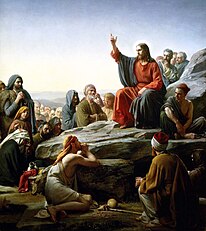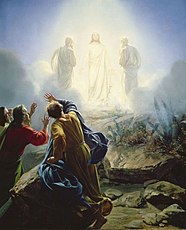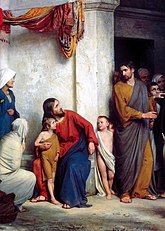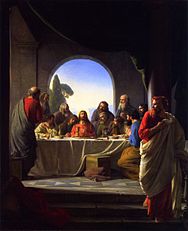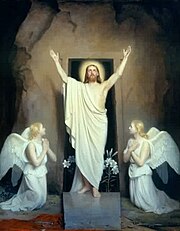Carl Bloch
You can help expand this article with text translated from the corresponding article in Danish. (February 2018) Click [show] for important translation instructions.
|
Carl Bloch | |
|---|---|
Royal Danish Academy of Art | |
| Notable work | In a Roman Osteria |
| Partner | Alma Trepka (died in 1886) |
| Website | www.carlbloch.org |
Carl Heinrich Bloch (Danish pronunciation: [ˈkʰɑːˀl ˈplɒk]; 23 May 1834 – 22 February 1890) was a Danish artist.
Biography


He was born in
His early work featured rural scenes from everyday life. From 1859 to 1866, Bloch lived in Italy, and this period was important for the development of his historical style.
His first great success was the exhibition of his "Prometheus Unbound" in Copenhagen in 1865. After the death of Marstrand, he finished the decoration of the ceremonial hall at the University of Copenhagen. The sorrow over losing his wife weighed heavily on Bloch, and being left alone with their eight children after her death was very difficult for him.
In a New Year's letter from 1866 to Bloch, H. C. Andersen wrote the following: "What God has arched on solid rock will not be swept away!" Another letter from Andersen declared "Through your art you add a new step to your Jacob-ladder into immortality."
In a final ode, from a famous author to a famous artist, H.C. Andersen said "Write on the canvas; write your seal on immortality. Then you will become noble here on earth."
He was then commissioned to produce 23 paintings for the King's Chapel at
Death and eulogies
Bloch died of cancer on 22 February 1890. His death came as "an abrupt blow for Nordic art" according to an article by Sophus Michaelis. Michaelis stated that "Denmark has lost the artist that indisputably was the greatest among the living." Kyhn stated in his eulogy at Bloch's funeral that "Bloch stays and lives."
A prominent Danish art critic, Karl Madsen, stated that Bloch reached higher toward the great heaven of art than all other Danish art up to that date. Madsen also said "If there is an Elysium, where the giant, rich, warm and noble artist souls meet, there Carl Bloch will sit among the noblest of them all!".[2]
Influence on art of The Church of Jesus Christ of Latter-day Saints
For over 40 years,
The church's interest in Bloch's work was generally kickstarted with
Through the assistance of Danish-born artist
Gallery
- Carl Heinrich Bloch - Life of Jesus
-
The Shepherds and the Angel
-
Jesus Tempted
-
Christ healing the sick
-
Healing of the Blind Man by Jesus Christ
-
Transfiguration
-
Suffer the Children
-
Raising of Lazarus
-
The Last Supper
-
Gethsemane
-
Christ on the Cross
-
Burial of Christ
-
The Resurrection Of Christ
See also
References
- ^ a b BYU Magazine, Winter 2011.
- ^ "Carl Heinrich Bloch Biography With All Details | carlbloch.org". www.carlbloch.org. Retrieved 2023-12-11.
- ISSN 0007-0106.
- ISSN 0007-0106.
- ^ McDonald, Amy (June 4, 2015). "Mormon-owned BYU acquires long-lost 'mysterious' Bloch painting of Jesus". The Salt Lake Tribune. Retrieved June 5, 2015.
- Biography and Online Gallery of Carl Bloch, Hope Gallery and CarlBlock.com, 2007, retrieved on: July 22, 2007
External links
- www.CarlBloch.org 43 paintings by Carl Heinrich Bloch
- Life of Christ: The Art of Carl Bloch
- Carl Bloch: The Master's Hand – information about Bloch and an exhibition about him at Brigham Young University Museum of Art






